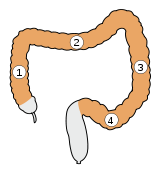Sigmoid colon

|

|
|
The human colon : |
Overview of the human gastrointestinal tract |
The sigmoid colon , also called sigmoid loop, sigmoid intestine or sigmoid and sigma for short , is the fourth and last, approximately 35–40 cm long part of the human large intestine ( colon , colon ). It is so called because it looks like (Greek -id -gestaltig; eidos similarity) that of the two Greek lowercase letters Sigma (ς), from which the Latin S developed.
anatomy
course
The sigmoid colon is located between the descending colon (descending colon) and rectum ( rectal ). For most people, the course of the intestine corresponds to a twisted S-curve, which, starting from the descending large intestine, rises again at about the level of the left ilium and then follows a twisted curve downwards until the upper end of the rectum reaches the level of the sacrum is. The sigmoid colon runs completely within the peritoneum (intraperitoneally), its upper third is fixed with delicate adhesions on the posterior peritoneum ( retroperitoneum ) of the left pelvic vane. The length of the sigmoid is variable.
Blood supply
The arterial supply of the sigmoid colon is provided by the arteriae sigmoideae , which arise from the arteria mesenterica inferior . A few centimeters after its direct exit from the abdominal aorta, this divides into the left colic artery (for supplying the descending colon ), the sigmoid arteries and the superior rectal artery (for supplying the rectum). Cross-connections between the adjacent supply areas ( anastomosing arcades ) running within the mesentery (mesentery) form a well-perfused supply vascular arch and, as a reserve supply, ensure the blood supply to the sigmoid colon even when the sigmoid arteries are occluded.
The venous drainage occurs via the inferior mesenteric vein , which initially accompanies the left colic artery upwards and then flows retroperitoneally behind the pancreas into the splenic vein and thus the portal vein circulation.
function
The function of the sigmoid consists in the further digestion and the "portioning" of the digestive residues to be eliminated. These have to remain in the rectum for a while for further dehydration. Only after it has been emptied can "supplies" reach the rectum via the sigmoid.
Surgical removal of the sigmoid ( sigmoid resection ) therefore initially results in increasingly watery, mushy to liquid stools in many cases. However, the high functional flexibility of the large intestine usually leads very quickly to a complete normalization of digestive activity.
Disease of the sigmoid colon
- Sigma diverticulosis
- Sigma diverticulitis
- Colon cancer